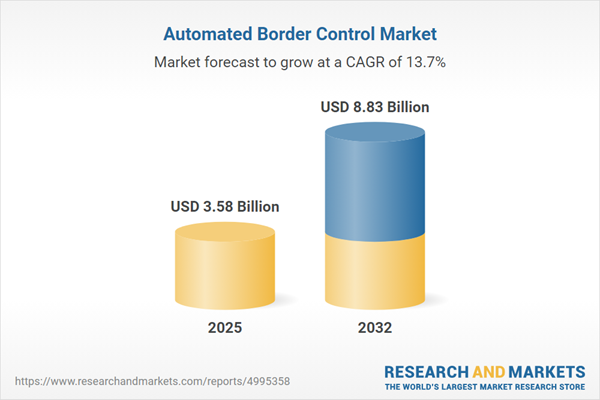Speak directly to the analyst to clarify any post sales queries you may have.
The global automated border control market is experiencing rapid evolution as governments and private operators integrate advanced technologies to support secure, seamless cross-border movement. This dynamic environment is reshaping operational priorities and investment strategies within international travel infrastructure.
Market Snapshot: Automated Border Control Market Opportunity
The Automated Border Control Market grew from USD 3.16 billion in 2024 to USD 3.58 billion in 2025. It is expected to continue growing at a CAGR of 13.67%, reaching USD 8.83 billion by 2032. Strong demand for seamless identity verification, combined with the deployment of biometric sensors, facial recognition, and advanced analytics, is redefining travel and security protocols worldwide. This accelerated growth reflects a convergence of regulatory objectives, technology adoption, and operational efficiency imperatives, positioning automated border control as an essential component of modern travel infrastructure.
Scope & Segmentation of the Automated Border Control Market
This report analyzes extensive market dimensions and covers the following critical aspects:
- Component: Biometric Sensors, Facial Recognition Systems, Fingerprint Scanners, Iris Recognition Systems, Consulting & Training, Maintenance & Support, System Integration, Biometric Identification Software, Border Control Management Software, Visitor Registration Software
- Module: E Gates, E Kiosks, Mobile Gates
- Application: Airports, Land Borders, Seaports
- End User: Airport Authorities, Border Security Forces, Government Agencies, Private Security Contractors
- Region:
- Americas: United States, Canada, Mexico, Brazil, Argentina, Chile, Colombia, Peru
- Europe, Middle East & Africa: United Kingdom, Germany, France, Russia, Italy, Spain, Netherlands, Sweden, Poland, Switzerland, United Arab Emirates, Saudi Arabia, Qatar, Turkey, Israel, South Africa, Nigeria, Egypt, Kenya
- Asia-Pacific: China, India, Japan, Australia, South Korea, Indonesia, Thailand, Malaysia, Singapore, Taiwan
- Key Companies: Accenture PLC, Atos SE, Cambaum GmbH, Cognitec Systems GmbH by Salto Systems, S.L., COMINFO, a.s., DERMALOG Identification Systems GmbH, eKiosk GmbH, Fujitsu Limited, Gunnebo AB, HID Global Corporation by ASSA ABLOY, IER SAS, IN Groupe, Indra Sistemas, S.A., Magnetic Autocontrol GmbH by FAAC SpA, Naitec S.r.l., NEC Corporation, NetSeT Global Solutions, Portwell, Inc. by Posiflex Technology, Inc., RTX Corporation, secunet Security Networks AG, Securiport LLC, Société Internationale de Télécommunications Aéronautiques S.C.R.L., Thales Group, Vancouver Airport Authority, Veridos GmbH
Technologies Featured
- Biometric Sensors
- Facial Recognition Algorithms
- Advanced Data Analytics and Cloud-Based Control Platforms
- Mobile Gate Solutions
Key Takeaways for Senior Decision-Makers
- Automated border control technology is rapidly shifting from experimental deployments to core travel infrastructure, driving measurable improvements in both traveler throughput and border security outcomes.
- Biometric innovation and the introduction of cloud-native platforms are enabling scalability and operational agility, giving agencies new capabilities to detect threats and facilitate legitimate travel without manual intervention.
- Strategic alliances between technology vendors, system integrators, and government agencies are accelerating deployment speed and ensuring solutions meet compliance mandates across diverse regulatory environments.
- Segment needs vary: airports prioritize passenger experience and speed, while land and seaport operators require rugged, mobile solutions for dynamic checkpoint environments.
- Regional adoption is influenced by policy harmonization, cross-border data-sharing, and large-scale infrastructure programs, creating nuanced opportunities for tailored deployment strategies.
- Continuous improvement and advanced analytics are increasingly central to optimizing verification accuracy and responding to emerging risks across border crossing points.
Tariff Impact: Navigating Cost and Supply Chain Pressures
- US tariffs in 2025 escalated costs for biometric hardware, leading to shifts in supply chain strategies, local manufacturing investments, and new service pricing models to mitigate economic volatility.
- Manufacturers and integrators responded by pursuing alternative sourcing, co-investment with local partners, and revising service contracts to support resilience against further trade disruptions.
Methodology & Data Sources
This research integrates primary interviews with stakeholders such as airport authorities and border security forces, in addition to secondary analysis of policy documents, technical whitepapers, and procurement data. Multi-source triangulation and expert validation ensure robust, credible insights.
Why This Report Matters
- Enables informed investment and partnership decisions by highlighting key trends in technology, regulatory adaptation, and operational best practices for automated border control.
- Delivers actionable recommendations on supply chain optimization, modular technology deployment, and compliance strategy in dynamic border environments.
Conclusion
Automated border control stands at the intersection of innovation, security, and global mobility. This report equips leaders to anticipate evolving challenges, align with emerging standards, and capture opportunities in a rapidly developing marketplace.
Additional Product Information:
- Purchase of this report includes 1 year online access with quarterly updates.
- This report can be updated on request. Please contact our Customer Experience team using the Ask a Question widget on our website.
Table of Contents
3. Executive Summary
4. Market Overview
7. Cumulative Impact of Artificial Intelligence 2025
Companies Mentioned
The companies profiled in this Automated Border Control market report include:- Accenture PLC
- Atos SE
- Cambaum GmbH
- Cognitec Systems GmbH by Salto Systems, S.L.
- COMINFO, a.s.
- DERMALOG Identification Systems GmbH
- eKiosk GmbH
- Fujitsu Limited
- Gunnebo AB
- HID Global Corporation by ASSA ABLOY
- IER SAS
- IN Groupe
- Indra Sistemas, S.A.
- Magnetic Autocontrol GmbH by FAAC SpA
- Naitec S.r.l.
- NEC Corporation
- NetSeT Global Solutions
- Portwell, Inc. by Posiflex Technology, Inc.
- RTX Corporation
- secunet Security Networks AG
- Securiport LLC
- Société Internationale de Télécommunications Aéronautiques S.C.R.L.
- Thales Group
- Vancouver Airport Authority
- Veridos GmbH
Table Information
| Report Attribute | Details |
|---|---|
| No. of Pages | 181 |
| Published | November 2025 |
| Forecast Period | 2025 - 2032 |
| Estimated Market Value ( USD | $ 3.58 Billion |
| Forecasted Market Value ( USD | $ 8.83 Billion |
| Compound Annual Growth Rate | 13.6% |
| Regions Covered | Global |
| No. of Companies Mentioned | 26 |




![Automated Border Control Market by Solution Type (E-gates, Kiosks), Component Type [Hardware (Document Verification, Biometrics (Facial, Iris Recognition), Software, Services], Application (Airports, Seaports, Land Ports) - Global Forecast to 2030 - Product Image](http://www.researchandmarkets.com/product_images/12487/12487156_60px_jpg/automated_border_control_market.jpg)




